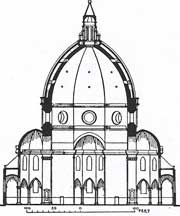Filippo Brunelleschi: The Duomo in Florence
In 1420, Filippo Brunelleschi was appointed to carry out the work at the Florence Dome (Il Duomo). His appointment was not easily obtained. The greatest difficulty seemed to be entertained with regard to the scaffolding and centering that was considered indispensable by every one except him.
Brunelleschi's Dome: Architectural Solution
Brunelleschi asserted again that the architecture of the Dome will not require heavy temporary supports, and that it can be built without centering. He insisted that the cupola must be double, so that the two walls being bound together should support each other.
Brunelleschi's Duomo - Section
Santa Maria del Fiore, Florence
His proposals were met with a shout of derision, and when he refused to accept other ideas, the commission said that he was obstructing the meeting, and was carried out by force. But the strong faith in his own architectural talent inspired others as well, and some people began to consider that it is really possible to build the Dome without scaffoldings.
One of them, Schiatta Ridolfi, employed Brunelleschi as architect for the family chapel, and Filippo could demonstrate, on a smaller scale, the principle he intended to use for Il Duomo.
Basically, a pole was attached horizontally by a pivot to the centre of the base of the cupola. It was then turned around step by step, with its point touching every brick being laid by the masons. This way the pole was raised gradually until the cupola is closed. At that stage, its position was perfectly perpendicular.
Still, the experiment did not convince his adversaries, who argued that what is possible for a small scale construction might not work for the cathedral. They asked to see Brunelleschi’s plans, which of course he refused. To make a decision, the Council initiated a competition. All participants had to provide models of their architectural plans. Filippo Brunelleschi made his brick and mortar model with the help of his friends: Donatello and Nanni di Banco.
To his model, Brunelleschi added scientific calculations and specifications. He indicated what height the sixteen buttresses on the sides must have. He also specified that the cupola must be built of stone only to a height of about twenty five feet, and after that brick must be used in order to lessen the weight of the fabric.
The Consuls and masters were very impressed, and it was indeed Filippo Brunelleschi's offer to construct the dome without centering that weighed most with the authorities in appointing him, but so little trust did they put in him that Ghiberti, his successful rival of the gates, who had no architectural experience, and Battista d'Antonio, were assigned him as colleagues. This arrangement did not go well with Filippo Brunelleschi’s temperament, Ghiberti retiring to work at his second pair of gates.
Construction of the Dome
The cupola of the Duomo was not entirely constructed till 1434. Domes had been constructed not so long before at Pisa, Siena, and at San Marco in Venice, but none of them on such a grand scale. The diameter was one hundred and thirty-eight and a half feet, and the altitude of the dome itself one hundred and thirty-three feet, measured from the cornice of the drum to the eye of the dome.
The difficulties Filippo Brunelleschi was facing were increased by the adoption of the drum on which the Duomo is raised, and through which it is lighted, while an important step is thus made in the progress of dome design. There is a separation between the inner and outer shell of the dome, but they are concentric, or nearly so.
As the altitude of the dome in itself is too great for good proportion internally or for decorative effects, the result might have been finer had the inner dome parted company from the outer with a lower centre, but that would have increased the thrust at the top of the drum. And it was Brunelleschi's aim to reduce that to a minimum, hence the acutely pointed form of both domes.
During the construction, Brunelleschi’s genius had many opportunities to manifest itself. When all the heavy stones had to be raised up to the top of the Dome, he invented a very efficient machine-lift.
The marble used for the Dome construction was brought from Pisa, and the process was very labor intensive and expensive. To solve the problem, he invented a sort of boat equipped with cranes, and the transport could be done at much less expense than before. He succeeded in getting his inventions exclusively attributed to him by the Signoria.
Begun after 1436, under Filippo Brunelleschi's superintendence, the lantern was only completed in 1461, after his death, and the gallery, round the drum on the outside, only on one of the eight sides at a later date. Brunelleschi left a model for the lantern, with instructions that it should be formed of large masses of marble to prevent the cupola from opening, believing that its pointed form was rendered more stable by loading it heavily. The construction of the Duomo is Gothic in principle, as the work is done by the eight main ribs and by the sixteen lighter intermediate ribs between which the vaults are stretched.
The Renaissance was the revival of classical principles. And this is exactly what Brunelleschi did. He was sure his idea will work, because while in Rome, he studied the Roman Empire architecture. He saw the same technique being used for the cupola of the Pantheon, where double walls were used.
Brunelleschi stood by his plans and won. He became the fashionable architect, and all the noble families in Florence wanted him to design their new “palazzo.”
The Dome was the largest work of Filippo Brunelleschi. "Il Duomo" became the symbol of Florence and granted the eternal life to one of the greatest architects of the Renaissance.
Filippo Brunelleschi - Life and the road to the Florence Dome.